According Special Notice #198 of the AAVSO is the old nova GK Per (1901) may be going into outburst.
Reports beginning late on 2010 March 6 UT show it brightening from its minimum visual magnitude of about 13.1
to 12.3-12.4.
The current probable outburst is occurring about 1180 days after the last outburst, so it may show more typical outburst behavior,
or it may do something completely unexpected.
Visual and CCD observers are asked to follow GK Per closely.
Dr. Phil Evans, University of Leicester, Engeland, will observer GK Per with the SWIFT satellite 3 times a day as ToO (Target of Opportunity).
Observations of GK Per can be downloaded through our lightcurvegenerator.
| Observation campaign Epsilon Auriga.update 07/01/2010
|
The second contact for the eclipsing binary Epsilon Auriga is predicted for midst January. According the visual observations it looks like Epsilon Auriga reached around the end of December some kind of plateau. Maybe the second contact began earlier? The photometry observations (not in this lightcurve) show the same trend. Further observations will show if Epsilon Auriga already has began totality.
Below the light curve of Epsilon Auriga.
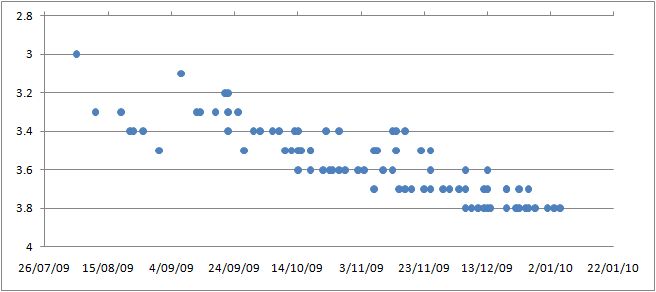
|
|
|
| KT Eri : a new nova in Eridanus update 28/12/2009
|
Central Bureau Electronic Telegram No. 2050 (Daniel W. E. Green, Ed) announces the discovery of a new nova in Eridanus on 25 nov. 2009. The nova was reported by
Hitoshi Yamaoka, Kyushu University, by K. Itagaki, Yamagata, Japan. At the moment of discovery reached the nova a magnitude of 8.1.
Low-resolution spectrum shows that the nova is a classical He/N nova about two weeks after maximum. The constellation Eridanus is well placed so the nova can be observed during a few months. The GCVS team assigned the name KT Eri to this nova.
The first time KT Eri was observed by our workgroup the nova reached magnitude 8.7. Later observations show a decline.
Below the light curve of KT Eri observed by Patrick Wils.
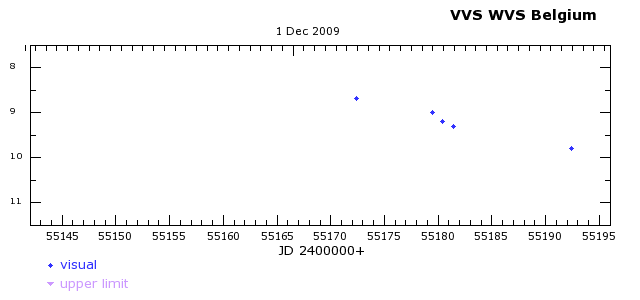
|
|
|
| Observing campaign of eps Aurigae in the IAY2009 update 21/10/2009
|
According to the predictions first contact should have taken place around Aug 6, 2009. However only around Aug 19 the first signs of dimming became visible. This delay can have several causes. According to the theory of Saito & Kitamura (1986 Ap & SS 122, 387) the main star can be shrinking.
Since the start of the eclipse the brightness of eps Aur has decreased half a magnitude. The predicted time of totality is December 21, 2009. It is unclear if this will also be delayed.
Below the light curve of Aur starting just before the eclipse.
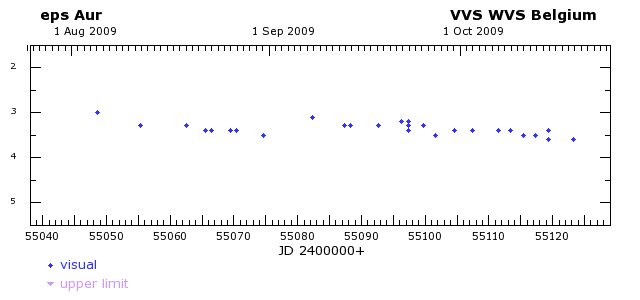
|
|
|
| AX Per eclipse has started upd 21 Aug 2009
|
According to the ephemerids of Skopal (IBVS 3603) the next eclipse of AX Per would take place mid July 2009. During this eclipse -which lasts for 85 days- the star will fade to magnitude 12.5 – 13. The observations of the working group show clearly that this eclipse has started. How faint the star will get can only be known in observing it. Just before the eclipse AX Per was heading to an outburst (see news item AX Per of April 21 aug 2009).
The light curve below clearly shows the increase in brightness before the eclipse (the light curve has a duration of 1000 days).
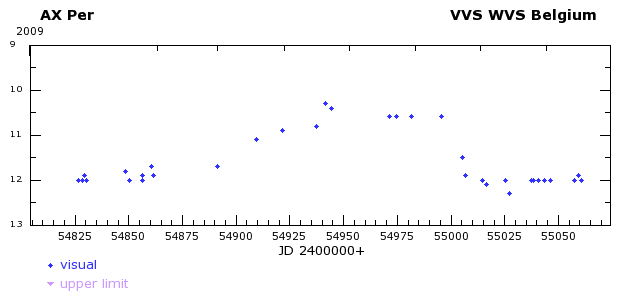
|
|
|
| AX Per on its way to an ourburst? upd 11 apr 2009
|
Symbiotic star AX Per seems to be heading for an outburst. U. Munari et al (CBET#1757, D.W.E Green, editor) indicates that the star brightened between February 28 and April 1. 2009. During its minimum AX Per has about magnitude 12. The last couple of months AX Per got brighter than magnitude 11. Also the colour of the start is bluer than normally: B=12.56 to B=11.55 and B-V = +1.08 to +0.82. This is the brightest since the outburst of 1988-1992. Spectroscopy reveals bright ionization lines. This can be the precursor of an outburst to the 1988-1992 one. AX Per will be observed visually, spectroscopically, and with filtered photometry.
The light curve below gives the activity of AX Per during the last three years, as observed by the VVS WGVS. The recent brightening is clearly visible.
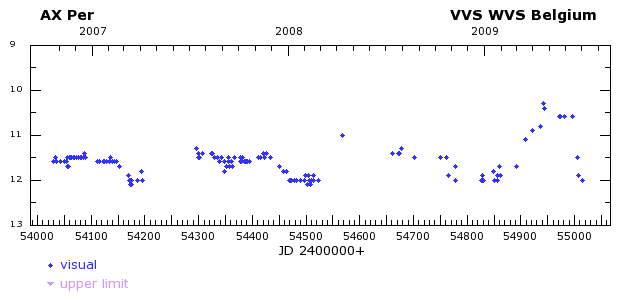
|
|
|
|
Observing campaign of Epsilon Aurigae within the framework of IYA 2009
|
Epsilon Aurigae is a bright star in the constellation of the Charioteer, which undergoes an eclipse every 27 years. This bright star can be seen with the unaided eye and can therefore be observed by everyone. Mid 2009 it will happen again: Eps Aur will decrease in brightness from magnitude 3 to 3.8. The eclipse will last for about two years! This implies that the eclipsed part is very large. In the middle of the eclipse there is a small increase in brightness. This must be due to a kind of cavity in the obscured body. Most likely a gigantic dust disc rotates around Eps Aur in 27 years. The ultimate answer is not known yet, and therefore observations are very welcome. The previous observations are of course from the previous eclipse during 1982-1984. In the meantime the observing techniques have improved a lot, and many amateurs have now professional equipment and techniques at their disposal. Also spectroscopy has entered the amateur field, and will turn out to be useful during this campaign. All eclipses since 1928 have been observed visually. The campaign of Working Group Variable Stars of the VVS will cover visual, photometric and spectroscopic observations. Hopefully this pro-am cooperation will increase our knowledge about this enigmatic star. The observations can start already now, as we have to know how Eps Aur behaves outside the eclipse, and we need to compare with the eclipse data.
If you want to participate in this observing campaign, please contact: Hubert.Hautecler@telenet.be
More information can also be found on the AAVSO site: http://www.aavso.org/vstar/vsots/eps_aur.shtml
and Epsilon Aurigae Campaign 2009
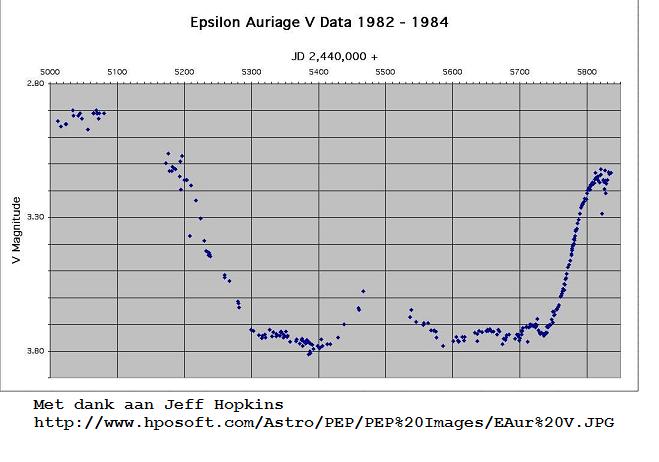
|
|
|
|
Observing program of High Amplitude Delta Scuti stars 14/03/2009
|
In 2008 the VVS working group variable stars started a project to observe HADS (“High Amplitude Delta Scuti” stars). Delta Scuti stars are pulsating stars with spectral class A to F, and periods between 1 and 6 hours.
In general their amplitudes are small, ranging from some hundredths to some tenths of a magnitude in the case of HADS. This information is important to research the evolution of Delta Scuti stars to validate theories which predict that their period increases. However decreasing periods are also possible, and are effectively observed. Often these stars show both radial pulsations (the star shrinks and expands, but keeps her spherical shape) and non-radial ones (surface waves). These non-radial pulsations enable asteroseismology and learn about the interior structure of stars.
Purpose of the project is to detect potential non-radial pulsations in some HADS, as well as finding possible period changes. The latter can be the result of intrinsic changes in the star (e.g. change in composition due to nuclear reactions), as well as extrinsic changes such as light travel time effects caused by a possible companion.
The first results of this observing campaign can be found in IBVS 5878
http://www.konkoly.hu/cgi-bin/IBVS?5878
|
|
|
|
EE Cep campaign 2008/2009
|
EE Cep is an eclipsing binary with a period of 5.5 year. Its minimum should be around 12 January 2009. We are starting an observingcampaing in the workgroup to follow this eclipsing binary. EE Cep is a blue and red star with eclipses between 30 and 60 days. The depth of the eclipse is also variable. This site is specially designed to coordinate the observing campaign : www.astri.uni.torun.pl/~cgalan/EECep/
Here you can find al the information about EE Cep. The call up for the observing campaing can you find here: www.konkoly.hu/cgi-bin/IBVS?5866
Our observations are send to Cezary Galan (Centrum Astronomii Uniwersytetu Mikolaja Kopernika w Toruniu, Poland), and are placed on his website.
If you want to join this campaign send an email to the workgroup leader at: Hubert.Hautecler@telenet.be
|
|
|
|
Outburst of GK Per? (update 12-10-2008)
|
The sudden outburst of GK Per has not reached his expected maximum brightness. Because this outburst was earlier then expected it was possible that GK Per wouldn't reach his maximum brightness. The maximum that was observed in our workgroup is magnitude 12.1. The maximum found in the AAVSO DB is 11.9. This is much fainter then the previous outbursts which reached magnitude 10. Meanwhile GK Per has reached again his minimum brightness of somewhat fainter then magnitude 13. It is always possible that GK Per will undergo some re-brightening. So keep on watching this star!
|
|
|
|
Ouburst of GK Per?
|
GK Per (Nova Per 1901) is since 10 september 2008 undergoing again an outburst. The last time it went in outburst was on 05/12/2006. This old nova shows regular outburst with an interval of 3 years. But with the last two outburst this tendency is not longer true. Between the last two outbursts, the time interval isn't even two years. It will also be possible that the maximum magnitude of magnitude 10 won't be reached. As always with variable stars, everything is possible. Keep on watching!
Charts for observing GK Per are free to download at the AAVSO website trough the VSP : http://www.aavso.org/observing/charts/vsp/
Information about how to observe and report the observations can you find in the left section of our website.
All GK Per observations dating back to 1979 are available from our online databank.
|
|
|
|
Another nova in Cygnus: V2491 Cyg! (updated 22-Apr-2008)
|
 IAUC 8934 announced the discovery of a nova in Cygnus.
IAUC 8934 announced the discovery of a nova in Cygnus.
The nova has been discovered by the Japanese observers Koichi Nishiyama and Fujio Kabashima on two 20 second unfiltered CCD
images taken on Apr. 10.728 UT. The discoverers used a 105mm (f/5.6) photolens. Their images show the nova at magnitude 7.7.
Nothing is visible on images made on Apr. 3.717 UT en Apr. 7.727 UT with a limiting magnitude of resp. 12.5 and 12.7.
The nova has also been discovered independently by the Chinese observers Z.-w. Jin and X. Gao on several 60s images taken
with a EOS-350D camera equiped with a 200 mm f/2.8 telelens. The images with a limiting magnitude of ~15 were taken at Xingming
Observatory, Mt. Nanshan on Apr. 10.831 UT. Nothing is visible on images taken on Apr. 8.831 UT with a limiting magnitude
of ~14.
According to E. Guido en G. Sostero (Remanzacco, Italy), a Palomar Oschin Schmidt telescope plate taken on 1995 Aug. 3 shows
a star with red magnitude 18 on the position of the nova. According K. Kadota (Ageo, Saitama-ken, Japan) also the USNO B1.0
catalogue contains a star at position R.A. 19h43m02s.039, Dec. +32o19'13".84 with red magnitudes 15.5 and 16.3. The epoch
for these magnitudes is evidently from the Palomar Sky Survey plates.
In CBET 1334 K. Ayani, Bisei Astronomical Observatory (BAO) and K. Matsumoto, Osaka Kyoiku University announced that low
resolution spectra taken with the 1.01 BAO telescope shows prominent broad Balmer emission lines, which indicate that
the object is a nova in its early phase of outburst.
N. N. Samus, Institute of Astronomy, Moscou, announced in IAUC 8934 that the nova was assigned the variable-star designation
V2491 Cyg.
The position as measured by Koichi Nishiyama en Fujio Kabashima using a 40cm reflector:
R.A. = 19h 43m 01.96s, Decl. = +32d 19' 13.8" (J2000.0)
More details are given in IAUC 8934 and CBET 1334.
Reported VVS observations
V2491 Cyg observations
V2491 Cyg light curve
V2491 Cyg spectra
Information for observers
Charts for observers
AAVSO VSP Charts (Chart code cfr upper right hand box):
V2491 Cyg, FOV 3° (b-scale)
V2491 Cyg, FOV 3° (b-scale), reversed
More information on observing variable stars and reporting observations:
Observing variable stars
Reporting observations
|
|
|
|
Joint Meeting of the AAVSO and BAA pictures online (updated 22-Apr-2008)
|
 From April 10th to April 13th 2008, the AAVSO and BAA organised a joint meeting in Cambridge, UK. A number of VVS members
attended this excelent meeting. The meeting started at Thursday evening with a dinner in New Hall. After the dinner the
old telescopes of the Cambridge Institute of Astronomy could be visited.
From April 10th to April 13th 2008, the AAVSO and BAA organised a joint meeting in Cambridge, UK. A number of VVS members
attended this excelent meeting. The meeting started at Thursday evening with a dinner in New Hall. After the dinner the
old telescopes of the Cambridge Institute of Astronomy could be visited.
The scientific paper sessions were scheduled
on Friday and Saturday. After the banquet on Saturday, Arne Henden presented the AAVSO awards. BAA VSS Director Roger Pickard
received the award of honorary AAVSO membership, Arto Oksanen received a Gamma-Ray Burst Award for discovering the optical
afterglow of GRB 071010B. Arne Henden also presented the observer awards, our member and founder Frans Van Loo received the
25000 visual observations award. Gary Poyner received the Charles Butterworth award from the VSS Director Roger Pickard.
On Sunday a trip to Stonehenge and Avebury was organised.
An extensive report on this meeting will be published in Heelal.
Pictures are online available.
|
|
|
|
Nova Cyg 2008 = V2468 Cyg! (updated 03-Apr-2008)
|
 CBET 1291 followed by IAUC 8927 announced the discovery of a nova in Cygnus.
CBET 1291 followed by IAUC 8927 announced the discovery of a nova in Cygnus.
The nova has been discovered by Hiroshi Kaneda on nine 4-s unfiltered images taken on Mar 7.801 UT, using a digital camera
equiped with a 105mm f/2.5 telephoto lens. Nothing was visible on images taken on October 5th 2007, Januari 1st 2008 and
February 18th. The limiting magnitude was ~10.5.
Nothing is visible on DSS plates within 20" of this nova to mag 13.0.
CBET 1291 mentions that following the announcement of a possible nova on the Central Bureau for Astronomical Telegrams'
unconfirmed-objects webpage, numerous additional claims of independent discovery have been received.
The first report came from Zhang-wei Jin and Xing Gao, Xingming Observatory, Mount Nanshan, China. They discovered the nova using
a Canon EOS 350D camera equiped with a 200 mm f/2.8 telephotolens (7-cm objective) on Mar. 7.881 UT and reported a mag ~8.1.
Their images taken on Mar. 2 and 5 don't show the nova. The images are available via
http://www.xjltp.com/XM08AD.htm.
Refer to CBET 1291 and IAUC 8927 for detailes information.
In IAUC 8928 N. N. Samus, Institute of Astronomy, Russian Academy of Sciences announced that the nova has been assigned the variable-star designation V2468 Cyg.
Position of the nova measured by K. Kadota (Ageo, Japan) using a 25cm reflector:
19h 58m 33.39s +29d 52' 06.5" (J2000)
Reported VVS observations
V2468 Cyg observations
V2468 Cyg light curve
Information for observers
Charts for observers
AAVSO VSP Charts (Chart code cfr upper right hand box):
N Cyg 08 (for usage with binoculars)
N Cyg 08, FOV 5.8° (upside-down, for usage without zenith prism)
N Cyg 08, FOV 5.8° (reversed, for usage with zenith prism)
N Cyg 08, FOV 1° (d-scale)
N Cyg 08, FOV 1° (d-scale), reversed
More information on observing variable stars and reporting observations:
Observing variable stars
Reporting observations
|
|
|
|
V459 Vul = Nova Vul 2007 No. 2! (updated 30-Dec-2007)
|
 CBET 1181 announces the discovery of a nova in Vul. After V458 Vul, this is the second nova discovered in the Vulpecula
constellation this year.
CBET 1181 announces the discovery of a nova in Vul. After V458 Vul, this is the second nova discovered in the Vulpecula
constellation this year.
Hiroshi Kaneda from Japan discovered the nova on three 4-s unfiltered images taken on Dec 25.35 UT using a Nikon D40 digital camera
equiped with a 105mm f/2.5 telelens. At the moment of discovery the nova was at magnitude ~8.7. Nothing is visible within 20" arround this
nova on DSS plates. Also on images taken by Kaneda on earlier dates, nothing is visible with a limiting magnitude of 10-11.
Akihiko Tago discovered the nova independently on images taken on Dec. 26.38 UT using a Canon 20D digital camera and Pentax 105mm
f/3.2 lens. The magnitude of the nova was ~8.3.
De position of the nova as measured by K. Itagaki on CCD frames made using a 60cm f/5.7 reflector:
19h 48m 08.84s +21d 15' 27.6" (J2000)
N. N. Samus en E. Kazarovets, Institute of Astronomy, Russian Academy of Sciences, announced that this nova is being given
the designation V459 Vul.
Reported VVS observations
V459 Vul observations
V459 Vul light curve
Information for observers
Charts for observers
Charts can be plotted with the AAVSO Variable Star Plotter: V459 Vul
More information on observing variable stars and reporting observations:
Observing variable stars
Reporting observations
|
|
|
|
Outburst of HS2331+3905! (updated 05-sep-2007)
|
 HS 2331+3905 is a unique cataclysmic variable never observed in outburst before. Up to now the star does not have an official
GCVS designation yet, the name HS 2331+3905 refers to the
Hamburg Quasar Survey catalogue.
HS 2331+3905 is a unique cataclysmic variable never observed in outburst before. Up to now the star does not have an official
GCVS designation yet, the name HS 2331+3905 refers to the
Hamburg Quasar Survey catalogue.
Hiroyuki Mehara discovered the outburst at V = 14.59 on Sep. 4.775 UT and announced it via VSNET (vsnet-alert 9530). M. Uemura,
A. Arai, M. Sasada en O. Nagae, KANATA team, Hiroshima University could confirm the outburst soon after the discovery
(vsnet-alert 9531). In the following 24 hours the star brightened up to magnitude 9. In quiesence the star is about magnitude 16.5.
HS 2331+3905 is probably a member of the WZ Sge stars. WZ Sge stars show outburst with a very large amplitude, but the outburst are
rare. This star is a very interesting one since the white dwarf in the system shows ZZ Ceti pulsations
(Araujo-Betancor et al., 2005, A&A 430, 629).
Reported VVS observations
HS 2331+3905 observations
HS 2331+3905 light curve
Information for observers
Charts for visual observers
AAVSO VSP charts (chart code 070905):
HS 2331+3905 (b-scale)
HS 2331+3905 (c-scal)
HS 2331+3905 (d-scale)
HS 2331+3905 (e-scale)
HS 2331+3905, reversed (b-scal)
HS 2331+3905, reversed (c-scale)
HS 2331+3905, reversed (d-scale)
HS 2331+3905, reversed (e-scale)
More information on observing variable stars and reporting observations:
Observing variable stars
Reporting observations
|
|
|
|
Possible nova in Vul = V458 Vul! (updated 02-Sep-2007)
|
 In IAUC 8863 N. N. Samus, Institute of Astronomy, Russian Academy of Sciences,
announced that this nova has been given the designation V458 Vul.
In IAUC 8863 N. N. Samus, Institute of Astronomy, Russian Academy of Sciences,
announced that this nova has been given the designation V458 Vul.
CBET 1027 announced the discovery of a possible nova in Vulpecula by Hiroshi Abe. Abe discovered the nova on images taken
on Aug. 8.54 UT using a Canon EOS Kiss Digital Camera with a 35-mm f/2.8 Pentax lens.
The nova was of magnitude 9.4 at the time of discovery. The 30s exposures gave a limiting magnitude about 11.5. Nothing was
visible on Abe's images taken on July 23 and 31 and Aug. 4.
De position measured by K. Kadota on CCD images taken with a 25cm f/5 reflector:
19h 54m 24.64s +20d 52' 51.9" (J2000)
Kadota adds that the USNO-A2.0 catalogue contains a star of r=18.1 and b=17.6 on position 19h 54m 24.66s +20d 52' 51.7".
Reported VVS observations
N Vul 07 observations
N Vul 07 light curve
Information for observers
Charts for visual observers:
AAVSO VSP charts (chart code 070902):
N Vul 07 (b-scale)
N Vul 07 (c-scale)
N Vul 07 (d-scale)
N Vul 07 (e-scale)
N Vul 07, reversed (b-scale)
N Vul 07, reversed (c-scale)
N Vul 07, reversed (d-scale)
N Vul 07, reversed (e-scale)
More information on observing variable stars and reporting observations:
Observing variable stars
Reporting observations
|
|
|
|
R CrB fading! (updated 21-juli-2007)
|
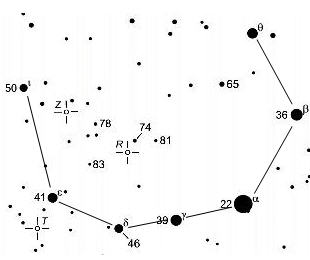 R CrB, the prototype of the R Coronae Borealis stars shows a decline for the first time since february 2003. Unpredictable
sudden fadings is the most prominent feature of these stars. R CrB may fade up to 8 magnitudes in a few weeks. In 2003 R CrB
faded in about 3 weeks from 6th magnitude to 13th magnitude. The star returned to maximum brightness by May 2003. The current
fading started arround July 7th. It is uncertain whether the star will show a deep minimum or not. Currently the star can be
easily observed using binoculars, later on a telescope may be required. R CrB can be easily located.
R CrB, the prototype of the R Coronae Borealis stars shows a decline for the first time since february 2003. Unpredictable
sudden fadings is the most prominent feature of these stars. R CrB may fade up to 8 magnitudes in a few weeks. In 2003 R CrB
faded in about 3 weeks from 6th magnitude to 13th magnitude. The star returned to maximum brightness by May 2003. The current
fading started arround July 7th. It is uncertain whether the star will show a deep minimum or not. Currently the star can be
easily observed using binoculars, later on a telescope may be required. R CrB can be easily located.
More information on R CrB can be read in the AAVSO
Variable Star of the Month, January 2000.
Reported VVS observations
R CrB observations
R CrB light curve
More observations are available through our online DB or light curve generator.
The 2003 fading : R CrB 2003 light curve
Information for observers
Charts voor visual observers
AAVSO charts are available:
R CrB AAVSO charts
More information on observing variable stars and reporting observations:
Observing variable stars
Reporting observations
Luc Janssens imaged R CrB on July 24th at 23h53 UT. R CrB is approximately equally bright as the 7.4 magnitude comparison star just NW of R CrB.
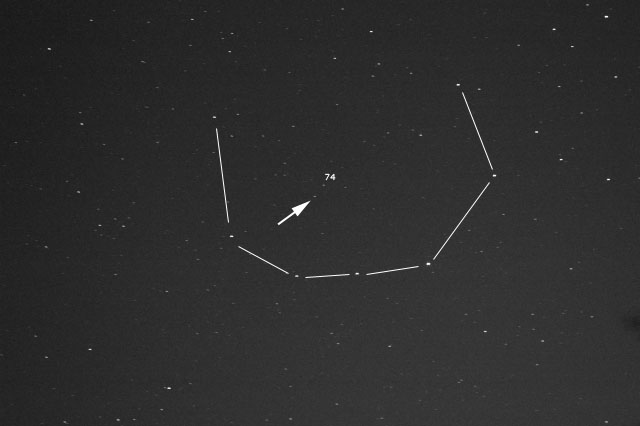
Click to enlarge.
Image: Luc Janssens (Nikon D70, Nikor 80-200mm op 80mm, f/2.8, 15sec, iso 1600)
|
|
|
|
Variable Stars Day on 12 May 2007 (updated 22-May-2007)
|
 The KNVWS and VVS Working groups Variable Stars gathered for a Variable Stars Day on 12 May 2007. The location for the meeting
was the Jan Paagman Sterrenwacht, Ostaderstraat 28, Asten, Netherlands (approx. 20 km east of Eindhoven, NL).
The KNVWS and VVS Working groups Variable Stars gathered for a Variable Stars Day on 12 May 2007. The location for the meeting
was the Jan Paagman Sterrenwacht, Ostaderstraat 28, Asten, Netherlands (approx. 20 km east of Eindhoven, NL).
Pictures and presentations of
the Variable Stars Day are now online available.
Thanks to the KNVWS-WVS for organising this meeting!
|
|
|
|
Variable star observers receive the VVS Galilei awards (updated 05-Mai-2007)
|
click to enlarge
 At the VVS membership meeting held in Gent on April 14th two variable star observers received the Galilei awards.
The Galilei awards are presented to VVS members who made significant contributions to the VVS.
At the VVS membership meeting held in Gent on April 14th two variable star observers received the Galilei awards.
The Galilei awards are presented to VVS members who made significant contributions to the VVS.
Wim Pessemier (right) received the bronze Galilei Award for his dedicated efforts in the local astronomical youth club JVS Sirius and for
his contributions of Variable Star Observations. The bronze Galilei award is presented to a youngster as an incentive.
The Silver Galilei award was presented to Johan Van Der Looy (left). Using his binoculars Johan observes mainly variable stars.
During the past 15 years he reported about 44000 variable star observations. Johan regularly writes articles for Heelal, the
monthly magazine of the VVS. He also gives presentations during the meetings of the VVS WVS and the VVS/JVS weekend.
|
|
|
|
Nova Cyg 2007 = V2467 Cyg (updated 09-Apr-2007)
|
 Akihiko Tago discovered a possible nova in Cygnus on March 15th. He found a "new" star of magnitude 7.4 on images taken with
a Canon 20Da digital camera (+ 70-mm f/3.2 lens; limiting magnitude 13.2 +/- 0.2). Nothing was visible at the same position on
images of March 12th with a limiting magnitude of 12.
Akihiko Tago discovered a possible nova in Cygnus on March 15th. He found a "new" star of magnitude 7.4 on images taken with
a Canon 20Da digital camera (+ 70-mm f/3.2 lens; limiting magnitude 13.2 +/- 0.2). Nothing was visible at the same position on
images of March 12th with a limiting magnitude of 12.
Low resolution spectra obtained with the 1.01 meter telescope of the Bisei Astronomical Observatory (BAO) and low resolution spectra
obtained with the 2 meter NAYUTA telescope of the Nishi-Harima Astronomical Observatory confirm the nova nature.
The nova has been given the official designation V2467 Cyg.
K. Nishiyama and T. Sakamoto, Bisei Spaceguard Center, reported following position:
R.A. = 20h 28m 12.52s, Decl. = +41o 48' 36.5" (2000.0)
A red USNO-catalogued star is located at position R.A. = 20h 28m 12.505s, Decl. +41o 48' 36.69s (red mag 18.5).
References:
CBET 890, CBET 891, IAUC 8821
Reported VVS observations
The Belgian weather prevented observations during the first week following the discovery announcement.
V2467 Cyg observations
V2467 Cyg light curve
Information for observers
Charts for visual observers
AAVSO VSP charts:
V2467 Cyg (FOV = 1°, faintest comp star = 13.7)
V2467 Cyg (FOV = 0.5°, faintest comp star = 15.3)
V2467 Cyg, reversed (FOV = 1°, faintest comp star = 13.7)
V2467 Cyg, reversed (FOV = 0.5°, faintest comp star = 15.3)
Older AAVSO VSP charts, still usefull to locate the nova:
V2467 Cyg (FOV = 3°, faintest comp star = 9.6)
V2467 Cyg (FOV = 2°, faintest comp star = 9.6)
V2467 Cyg, reversed (FOV = 3°, faintest comp star = 9.6)
V2467 Cyg, reversed (FOV = 2°, faintest comp star = 9.6)
BVRI sequence for CCD observers
Following preliminary sequence for CCD observers is available from the AAVSO FTP site: AAVSO BVRI sequence.
More information on observing variable stars and reporting observations:
Observing variable stars
Reporting observations
|
|
|
|
Outburst of GK Per? (updated 17-Dec-2006)
|
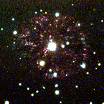 Recent observations show a brightening of GK Per (Nova Per 1901).
Recent observations show a brightening of GK Per (Nova Per 1901).
This old nova displays an outburst pattern resembling those of dwarfnovae. The duration of GK Per's outbursts are however
longer than those of dwarfnovae. Usually the rise to maximum brightness takes about one month.
The last outburst of GK Per dates back to the second half of 2004. That outburst was somewhat unusual, the rise to maximum
brightness took about 2 months and happened in two stages with a minor fading in between. This is clearly shown in our
light curve.
The recurrence time of the outbursts is usually about 3 years. The current brightening comes somewhat earlier than
expected and it is unclear whether GK Per will show a normal outburst.
Reported VVS observations
GK Per observations from 1 dec 2006 on
GK Per light curve from 1 juni 2004 on
All GK Per observations dating back to 1979 are available from our online DB.
Information for observers
Charts for visual observers
AAVSO charts are available.
Please use these charts to observe this star:
AAVSO charts
More information on observing variable stars and reporting observations:
Observing variable stars
Reporting observations
BV sequence for CCD observers
Following sequence for CCD observers is available from the AAVSO website: AAVSO BV sequence.
|
|
|
|
V2362 Cygni (= Nova Cyg 2006) fading rapidly (updated 11-Dec-2006)
|
 After a re-brightening phase which started in July 2006, V2362 Cygni is rapidly fading.
After a re-brightening phase which started in July 2006, V2362 Cygni is rapidly fading.
In CBET 769, U. Munari et al. announced that the current decline started around Nov. 30.2 UT. The light curve is very
similar to the one of V1493 Aql (Nova Aql 1999). Light curves of both novae composed with observations from the VVS WVS members
are available at the links below. Note that the time scale and magnitude scale is different. The re-brightening phase for
V2362 Cygni took much longer than for V1493 Aql. The amplitude of the re-brightening is only slightly larger for V2362 Cyg.
Observations are available from our online database or directly via the links given below.
More information on this nova can be found on the AAVSO website.
Reported VVS observations
V2362 Cyg observations
V2362 Cyg light curve
Compare the light curve with the one of V1493 Aql:
V1493 Aql observations
V1493 Aql light curve
Information for observers
Charts for visual observers
The AAVSO has a chart available.
Please use this chart for your observervations:
d-chart
reversed d-chart
AAVSO VSP chart up to magnitude 15
reversed AAVSO VSP chart up to magnitude 15
BVRI sequence for CCD observers
Following sequence for CCD observers is available from the AAVSO FTP site: AAVSO BVRI sequence.
More information on observing variable stars and reporting observations:
Observing variable stars
Reporting observations
BVRI sequence for CCD observers
Following sequence for CCD observers is available from the AAVSO FTP site: AAVSO BVRI sequence.
|
|
|
|
Successful Variable Stars Day on 13 May 2006 (updated 20-May-2006)
|
 The Variable Stars Day organised on Saturday 13 May 2006 was very succesful.
The Variable Stars Day organised on Saturday 13 May 2006 was very succesful.
About 20 participants gathered at the Europlanetarium
in Genk, among them colleagues from the Dutch KNVWS WVS
and one from the German BAV.
We were pleased to have AAVSO Director Dr. Arne Henden as
guest lecturer on our meeting.
Pictures and presentations (partly) of
the Variable Stars Day are now online available.
Thanks to all participants, speakers, everyone who helped organising this meeting and the
Europlanetarium for providing the meeting room.
|
|
|
|
Nova in Cygnus! (updated 05-Apr-2006)
|
N. N. Samus, Russian Academy of Sciences, announced in IAUC No. 8698 that the
nova has been assigned the official designation V2362 Cyg.
The same IAUC reports also that low resolution spectra taken by several Japanese observers suggest
a classical nova caught at or slightly before its maximum light.
The AAVSO released improved charts to observe the nova:
http://www.aavso.org/cgi-bin/searchcharts3.pl?name=n%20cyg%2006.
Observations made by the VVS WVS observers can be plotted with the VVS WVS light curve generator
or retrieved from the VVS WVS online DB using the starname V2362 Cyg.
The discovery of the nova by H. Nishimura (Miyawaki, Kakegawa, Japan) had been announced by
the Central Bureau of Astronomical Telegrams (CBAT) in IAUC No. 8697.
Nishimura found the new object (mag 10.5) on two Kodak T-Max 400 films taken on Apr. 2.807 UT using
a Pentax 6x7 camera (+ 200-mm f/4.0 lens; 60-s exposures).
Nothing was present at this location on his films taken on Mar. 28 (limiting mag 12) or on earlier patrol
films back to Oct. 2001.
On request of the AAVSO R. Miles (Stourton Caundle, Dorset, Engeland) confirmed the existence of the object
with a CCD image taken on Apr. 4.995. Miles reported a magnitude of V = 8.5 +/- 0.3 and following
precise position:
R.A. = 21h11m32.34s, Decl. = +44o48'03".9 (uncertainty +/- 0.3", equinox 2000.0).
Miles states that nothing is visible at this location on a Digitized Sky Survey image.
|
|
|
|
Rare outburst of RS Oph! (13-Feb-2006)
|
The recurrent nova RS Oph went in outburst for the first time since 1985.
The outburst has been discovered by the Japanese observers Kiyotaka Kanai (Gunma,Isezaki-shi) and Hiroaki Narumi
(Ehime,Kita-gun) and was reported on the VSNet-Alert mailing list. H. Narumi estimated the brightness on
Feb. 12.829 UT at magnitude 4.5 and K. Kanai somewhat later at magnitude 4.6.
The previous outburst dates back from 28th Januari 1985 when RS Oph reached a maximum magnitude of 5.4.
The recurrence time (time interval between outbursts) differs a lot from one outburst to the other. Other outbursts
have been observed in 1898, 1933, 1958, 1967 and 1985. The behavior during the outbursts is surprisingly similar in
nature.
Typically RS Oph brightens from minimum (around magnitude 11.5) to maximum in less than 24 hours. The star fades in
3 stages, during the first ~40 days the star fades at about 0.1 magnitudes per day, followed by a slower decline
at about 0.02 mag/day during 40 a 50 days. During the last stage the star fades again more quickly at about 0.05
mag/day. The duration of the complete outburst takes about 100 - 120 days. During quiescence the star displays
variations with an amplitude of 1 to 3 magnitudes.
Only 2 observations of the 1985 outburst could be reported by Frans Van Loo to the VVS WVS.
Hopefully this time more VVS WVS observers will be able to observe this interesting object.
Please use the most recent AAVSO charts to make your observations. The charts are available
here.
More information on RS Oph:
AAVSO VSOTM May 2000
AAVSO Alert Notice 335
|
|
|
|
|
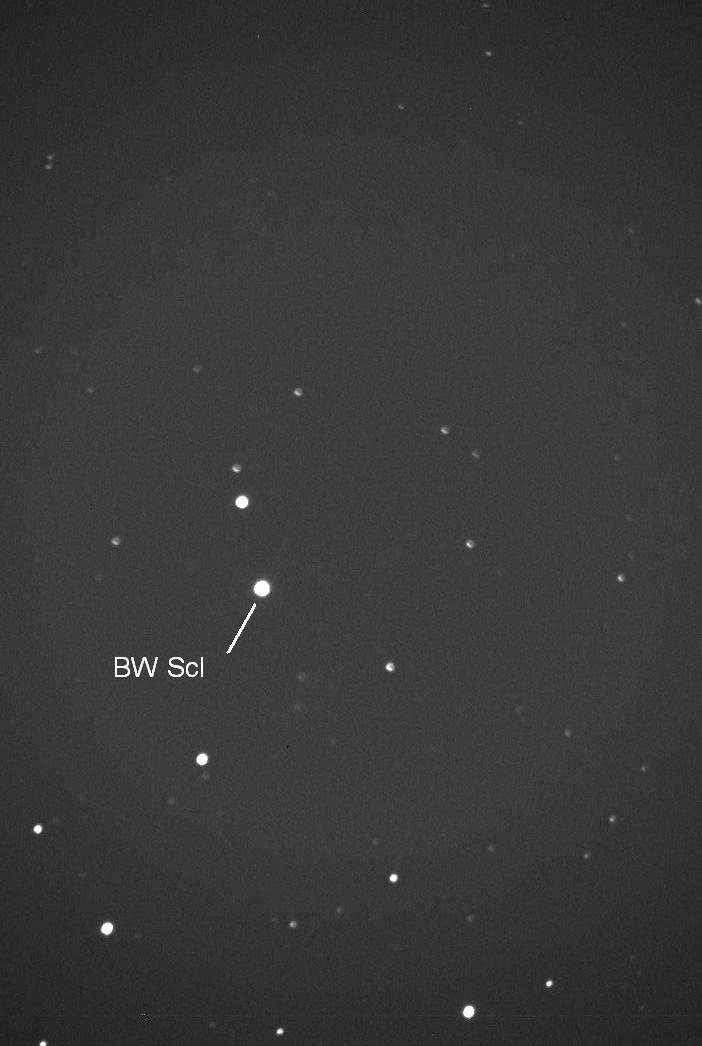
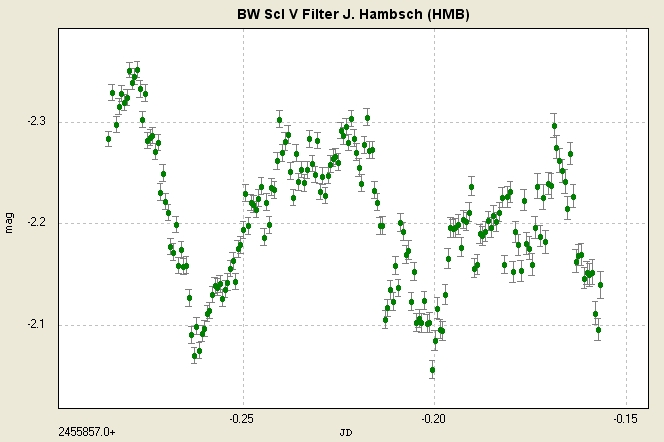
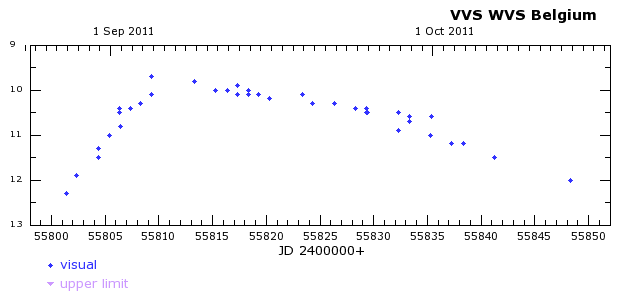
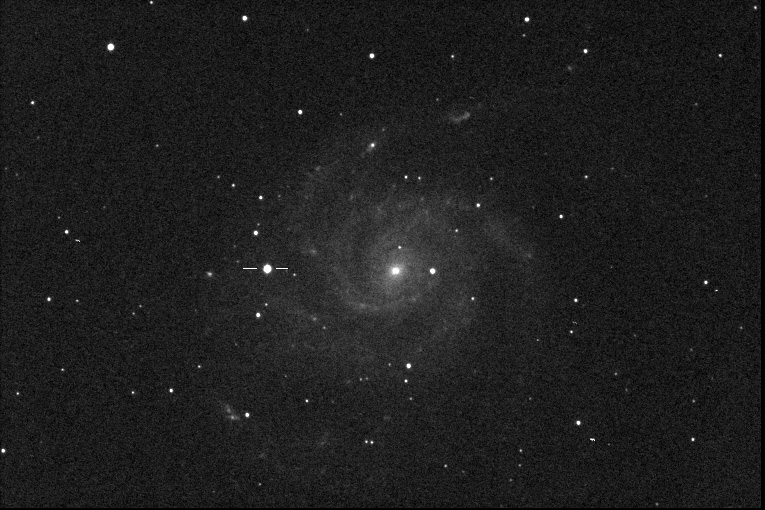
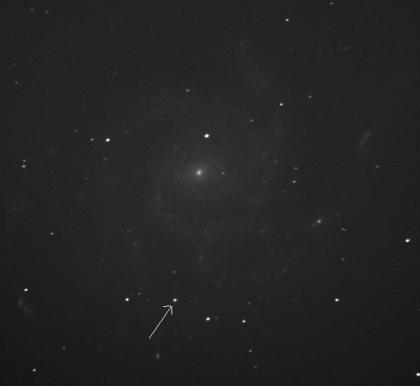
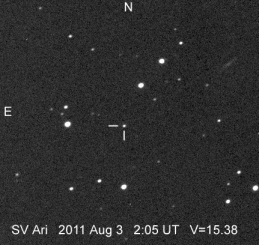
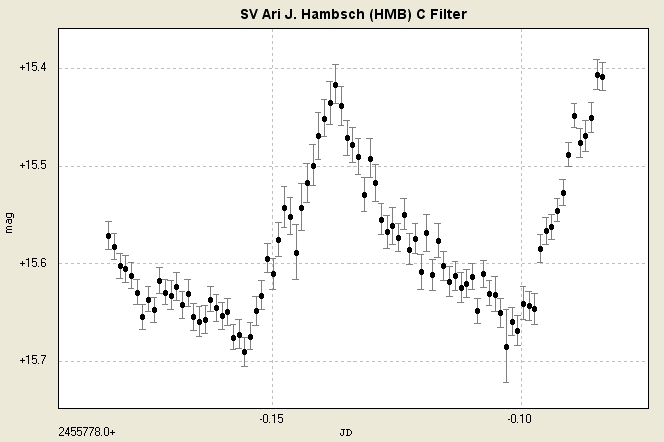
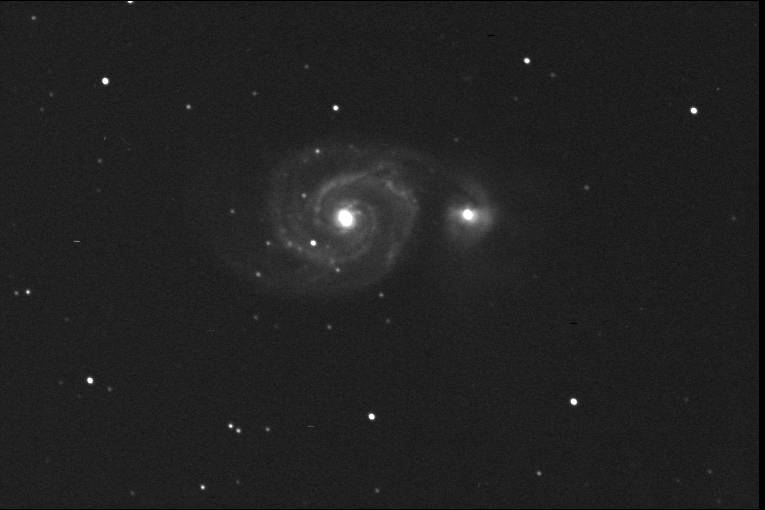
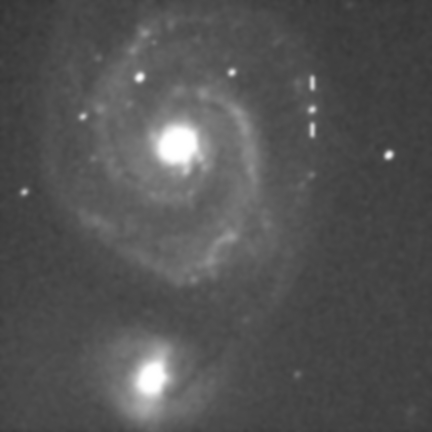
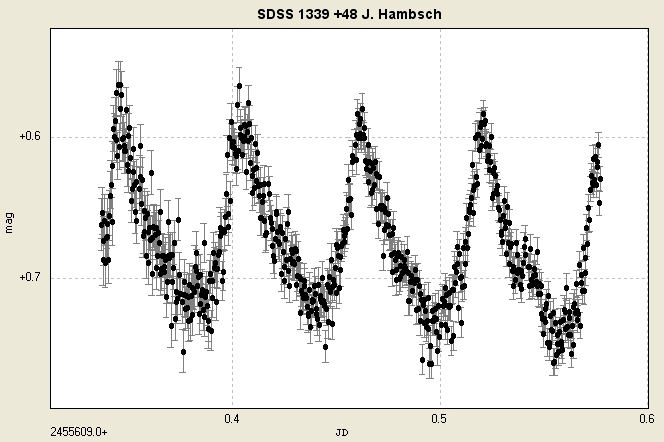
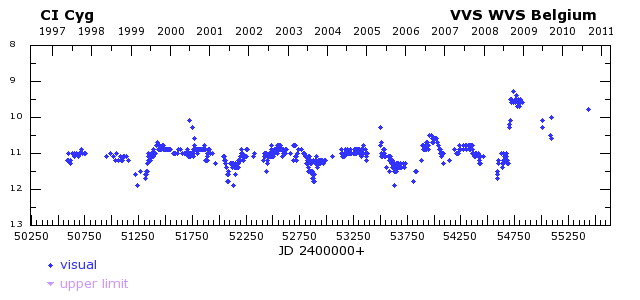
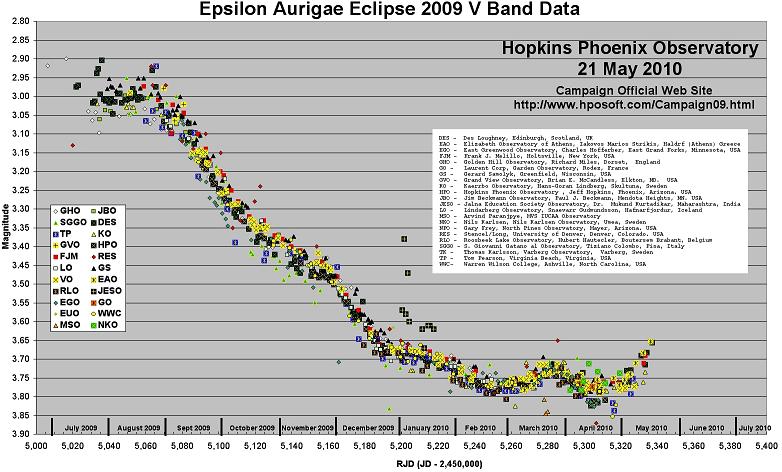
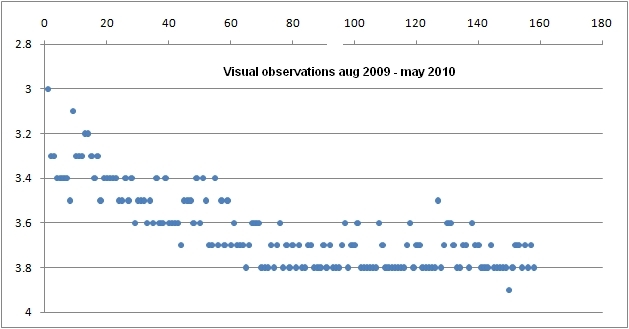
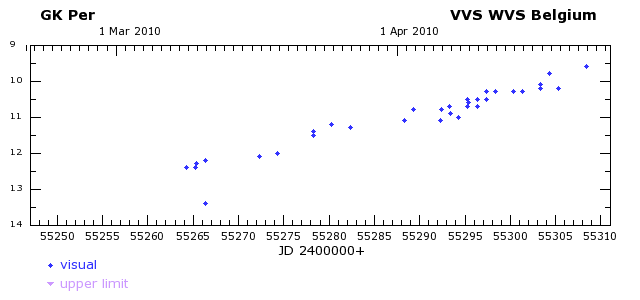
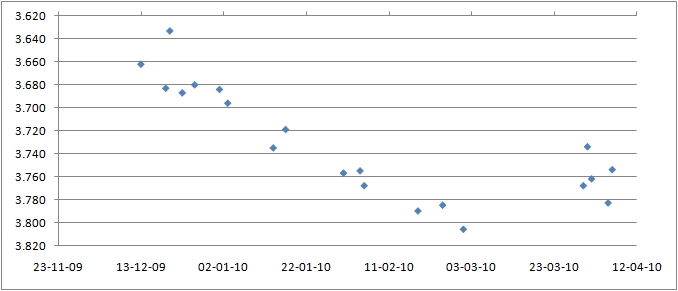
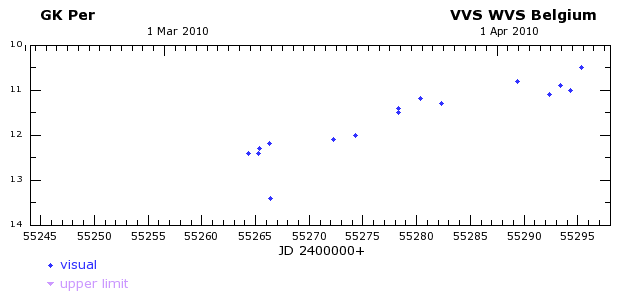
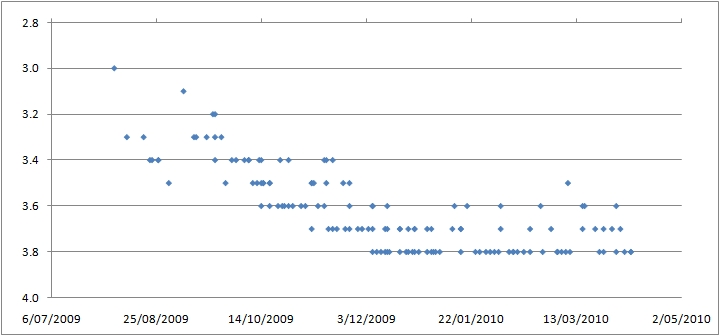

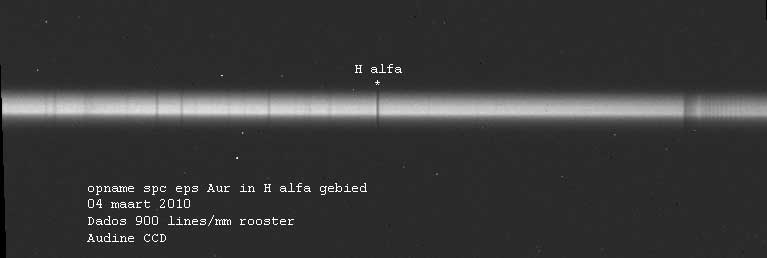






 IAUC 8934 announced the discovery of a nova in Cygnus.
IAUC 8934 announced the discovery of a nova in Cygnus. From April 10th to April 13th 2008, the AAVSO and BAA organised a joint meeting in Cambridge, UK. A number of VVS members
attended this excelent meeting. The meeting started at Thursday evening with a dinner in New Hall. After the dinner the
old telescopes of the Cambridge Institute of Astronomy could be visited.
From April 10th to April 13th 2008, the AAVSO and BAA organised a joint meeting in Cambridge, UK. A number of VVS members
attended this excelent meeting. The meeting started at Thursday evening with a dinner in New Hall. After the dinner the
old telescopes of the Cambridge Institute of Astronomy could be visited. R CrB, the prototype of the R Coronae Borealis stars shows a decline for the first time since february 2003. Unpredictable
sudden fadings is the most prominent feature of these stars. R CrB may fade up to 8 magnitudes in a few weeks. In 2003 R CrB
faded in about 3 weeks from 6th magnitude to 13th magnitude. The star returned to maximum brightness by May 2003. The current
fading started arround July 7th. It is uncertain whether the star will show a deep minimum or not. Currently the star can be
easily observed using binoculars, later on a telescope may be required. R CrB can be easily located.
R CrB, the prototype of the R Coronae Borealis stars shows a decline for the first time since february 2003. Unpredictable
sudden fadings is the most prominent feature of these stars. R CrB may fade up to 8 magnitudes in a few weeks. In 2003 R CrB
faded in about 3 weeks from 6th magnitude to 13th magnitude. The star returned to maximum brightness by May 2003. The current
fading started arround July 7th. It is uncertain whether the star will show a deep minimum or not. Currently the star can be
easily observed using binoculars, later on a telescope may be required. R CrB can be easily located.
 The KNVWS and VVS Working groups Variable Stars gathered for a Variable Stars Day on 12 May 2007. The location for the meeting
was the
The KNVWS and VVS Working groups Variable Stars gathered for a Variable Stars Day on 12 May 2007. The location for the meeting
was the 
 Recent observations show a brightening of GK Per (Nova Per 1901).
Recent observations show a brightening of GK Per (Nova Per 1901). The Variable Stars Day organised on Saturday 13 May 2006 was very succesful.
The Variable Stars Day organised on Saturday 13 May 2006 was very succesful.